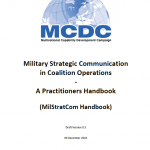
Cell phones, smart phones, the Internet, and GPS are increasingly available and are changing the nature of conflict, even in remote areas. Information can now reach out in new ways to global audiences because of the revolution in Information Technology (IT), particularly using cell phones and smart phones. The revival of hybrid warfare manifested in recent developments in the international security environment – such as the Arab Spring, the Ukrainian crisis, the rise of Jihadist-Salafist terrorism, and the European migrant crisis – demonstrates the power of communication, broadly based on IT advantages: messages and perceptions become predominant of physical engagements and strongly impact the behaviour of people. Orchestrated activities carry messages and have a crucial effect on 55 public opinions, decision-making processes, and domestic support.
